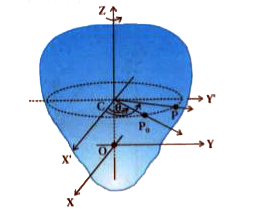Write the change in magnitude and direction of angular velocity with respect to time of a rotating body about a fixed axis. Solution in Gujrati
It will be in the direction perpendicular to plane form by circular path and parallel to the axis.
Topper's Solved these Questions
- SYSTEMS OF PARTICLES AND ROTATIONAL MOTIONBOOK - KUMAR PRAKASHANCHAPTER - SYSTEMS OF PARTICLES AND ROTATIONAL MOTIONEXERCISE - SECTION-D NCERT EXEMPLAR SOLUTIONS
13 Videos
- SYSTEMS OF PARTICLES AND ROTATIONAL MOTIONBOOK - KUMAR PRAKASHANCHAPTER - SYSTEMS OF PARTICLES AND ROTATIONAL MOTIONEXERCISE - SECTION-D NCERT EXEMPLAR SOLUTIONS (VERY SHORT ANSWER TYPE QUESTIONS)
5 Videos
- SYSTEMS OF PARTICLES AND ROTATIONAL MOTIONBOOK - KUMAR PRAKASHANCHAPTER - SYSTEMS OF PARTICLES AND ROTATIONAL MOTIONEXERCISE - SECTION-B NUMERICAL FROM .DARPAN. BASED ON TEXTBOOK
17 Videos
- QUESTIONS ASKED IN JEE - 2020 BOOK - KUMAR PRAKASHANCHAPTER - QUESTIONS ASKED IN JEE - 2020 EXERCISE - Question
16 Videos
- THERMAL PROPERTIES OF MATTERBOOK - KUMAR PRAKASHANCHAPTER - THERMAL PROPERTIES OF MATTEREXERCISE - Question Paper (Section - D) (Answer following in brief :) Each carry 4 marks
1 Videos
Similar Questions
For which of the following does the centre of mass lie outside the body?
View SolutionThe centre of gravity of a body on the earth coincides with its centre of mass for a small object whereas for an extended object it may not. What is the qualitative meaning of small and extended in this regard? For which of the following two coincides? A building, a pond, a lake, a mountain?
View SolutionThe particles of mass m1,m2andm3 are placed on the vertices of an equilateral triangle of sides .a.. Find the centre of mass of this system with respect to the position of particle of mass m1.

View SolutionA non-isotropic solid metal cube has coefficient of linear expansion as 5×10−5/∘C along the x-axis and 5×10−6/∘C along y-axis and z-axis. If the coefficient of volumetric expansion of the solid is n×10−6/∘C then the value of n is....
View SolutionIn an experiment on the specific heat of a metal, a 0.20 kg block of the metal at 150∘C is dropped in a copper calorimeter (of water equivalent 0.025 kg) containing 150 cm3 of water at 27∘C. The final temperature is 40∘C. Compute the specific heat of the metal. If heat losses to the surroundings are not negligible, is your answer greater or smaller than the actual value for specific heat of the metal ?
View SolutionDoes a body rotating about a fixed axis have to be perfectly rigid for all points on the body to have the same angular velocity and the same angular acceleration ?Explain.
View SolutionAssertion: If the head of a right handed screw rotates with the body, the screw advances in the direction of the angular velocty. Reason: For rotation about a fixed axis, the angular velocity vector lies along the axis of rotation.
View SolutionIf I, alpha and tau are the moment of inertia, angular acceleration and torque respectively of a body rotating about an axis with angular velocity omega then,
View SolutionIf I, alpha and tau are MI, angular acceleration and torque respectively of a body rotating about any axis with angular velocity omega , then
View SolutionFor a rotating body about fixed axis ,
View SolutionAngular Momentum of a Body Rotating About Fixed Axis of Rotation
View SolutionRotational Motion | Angular Momentum Of A Body Rotating About Fixed Axis.
View Solution(A) : Direction of angular velocity is always perpendicular to plane of rotation.
(R ) : If the axis of rotation is fixed direction of angular velociy does not change.
View SolutionExplain angular velocity and angular acceleration about fixed axis and derive the equation of rotational motion and write the analogy between the equations of linear motion and rotational motion.

View SolutionWrite the change in magnitude and direction of angular velocity with respect to time of a rotating body about a fixed axis.
View SolutionAssertion: If the head of a right handed screw rotates with the body, the screw advances in the direction of the angular velocty.
Reason: For rotation about a fixed axis, the angular velocity vector lies along the axis of rotation.
View Solution
